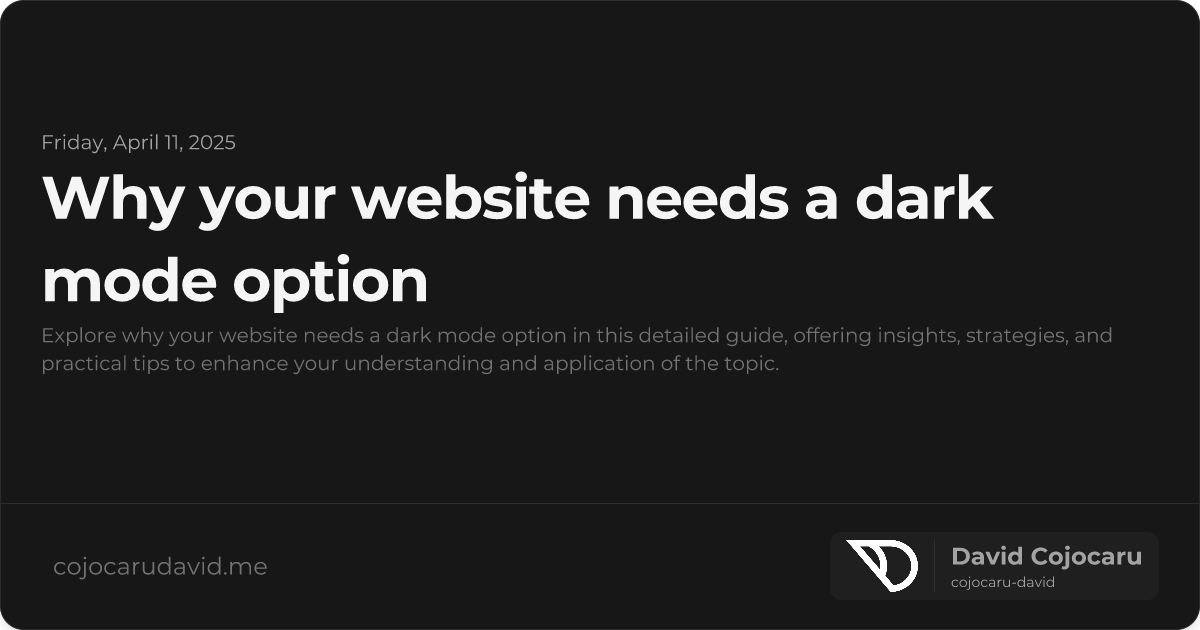Why Dark Mode is Essential for Your Website
In today’s digital world, user experience reigns supreme. Offering a dark mode option for your website isn’t just following a trend; it’s providing a vital feature that enhances usability and caters to diverse user needs. Dark mode reduces eye strain, conserves battery life on certain devices, and can improve readability, making it a popular choice for many users. By implementing dark mode, you demonstrate a commitment to accessibility and user satisfaction.
The Rise of Dark Mode
Dark mode has exploded in popularity across various platforms, from smartphone operating systems and apps to desktop environments. Users actively seek out this feature for its sleek aesthetics and perceived functional advantages. Websites that neglect this preference risk alienating a significant portion of their potential audience and missing an opportunity to improve engagement.
Key Benefits of Dark Mode:
- Reduced Eye Strain: Lessens eye fatigue, especially in low-light conditions or during extended screen time.
- Extended Battery Life (OLED/AMOLED): Darker pixels consume less power on OLED and AMOLED screens, leading to longer battery life.
- Enhanced Readability: Can improve text clarity for users with light sensitivity or visual impairments.
- Modern Aesthetic: Provides a visually appealing, contemporary look that many users find preferable.
Elevating User Experience with Dark Mode
A well-implemented dark mode contributes to a more enjoyable and personalized browsing experience. When users have control over their viewing preferences, they’re likely to stay on your site longer, explore more content, and return in the future. This improved experience fosters user loyalty and can significantly reduce bounce rates.
Implementing Dark Mode: A Practical Guide
- CSS Variables &
prefers-color-scheme: Utilize CSS variables to define your color palette and theprefers-color-schememedia query to automatically detect the user’s preferred theme. - Manual Toggle Switch: Offer a prominent toggle switch that allows users to manually switch between light and dark modes, overriding system preferences.
- Prioritize Contrast: Carefully select color combinations to ensure adequate contrast between text and background, maintaining readability in dark mode.
- Thorough Testing: Test your dark mode implementation across various devices and browsers to guarantee a consistent and optimal experience.
Accessibility and Inclusivity Considerations
Dark mode transcends mere aesthetics; it’s a critical accessibility feature for many users. Individuals with visual impairments, light sensitivity (photophobia), or other conditions may find dark interfaces significantly more comfortable and easier to navigate. By providing dark mode, you’re making your website more inclusive and accessible to a wider audience.
Best Practices for Dark Mode Accessibility:
- Contrast Ratio: Adhere to a minimum contrast ratio of 4.5:1 for text and background colors to ensure readability, as recommended by WCAG (Web Content Accessibility Guidelines).
- Avoid Pure Black: Using pure black (#000000) can create excessive glare on some screens. Opt for a slightly darker shade of gray instead.
- User Testing: Conduct user testing with individuals who have visual impairments to gather valuable feedback and identify areas for improvement.
Technical Snippet: Getting Started
Implementing dark mode doesn’t have to be complex. Here’s a basic CSS example to illustrate the core principles:
:root {
--bg-light: #ffffff;
--text-light: #333333;
--bg-dark: #1a1a1a;
--text-dark: #f0f0f0;
}
body {
background-color: var(--bg-light);
color: var(--text-light);
}
@media (prefers-color-scheme: dark) {
body {
background-color: var(--bg-dark);
color: var(--text-dark);
}
}This snippet utilizes CSS variables and the prefers-color-scheme media query to automatically switch between light and dark themes based on the user’s system settings. For more dynamic control, you can incorporate JavaScript to toggle themes based on user interaction.
Conclusion: Embrace Dark Mode
Dark mode has evolved from a trend into an expectation for modern websites. By prioritizing user experience, accessibility, and visual appeal, you can create a more engaging and inclusive online environment. Implementing dark mode demonstrates a commitment to your users and positions your website for long-term success. Embrace dark mode and provide your users with the flexibility and comfort they deserve.
“Dark mode is more than just a design fad; it’s a commitment to user-centric design that prioritizes comfort and accessibility in the digital realm.”

